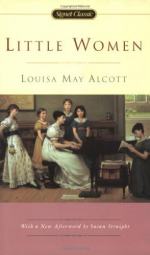|
This section contains 7,893 words (approx. 27 pages at 300 words per page) |

|
SOURCE: "A Portrait of the Artist as a Little Woman," Children's Literature. Vol. 17, 1989, pp. 81-97.
In the following essay, Clark discusses Alcott's ambivalence toward the role of writing, particularly as self-expression, in Little Women.
Alcott as submissive, Alcott as subversive, Alcott as ambivalent—these are dominant themes in recent reflections on Louisa May Alcott.1 The same themes appear in Alcott's own writing about writing, when she writes about Jo March. Though Alcott gives some play to subversive ideas of self-expression, her overt message is that girls should subordinate themselves and their language to others. A little woman should channel her creativity into shaping the domestic space or shaping her soul. She can enact Pilgrim's Progress and learn to live as a Christian—to live by God's Word, or by John Bunyan's word, not by her own.2
Nineteenth-century male authors send a very different message to their readers. Jan...
|
This section contains 7,893 words (approx. 27 pages at 300 words per page) |

|


